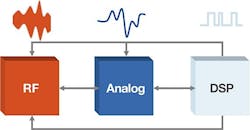RF and microwave, cyber, and anti-tamper are cornerstones of Mercury acquisition of Microsemi segment
THE MIL & AERO COMMENTARY 31 May 2016. Enhancing the company's expertise in RF and microwave, cyber security, and anti-tamper technologies are cornerstones of the recent acquisition by Mercury Systems of the embedded security, RF and microwave, and custom microelectronics businesses from Microsemi Corp.
Mercury has completed its acquisition of the Microsemi embedded security, RF and microwave, and custom microelectronics businesses for $300 million.
The Microsemi segments that Mercury is acquiring formerly were known as White Electronic Designs Corp. in Phoenix; the Endwave Corp. defense electronics and security (D&S) business in Camarillo, Calif.; and Arxan Defense Systems in West Lafayette, Inc.
Microsemi acquired Endwave Defense in 2009, and acquired White Electronic Designs and Arxan Defense Systems in 2010. Now the core expertise of those business segments passes to Mercury, which in recent years has carved out a niche in electronic warfare, RF and microwave technologies, and high-performance embedded computing.
Endwave Defense had specialized in high-frequency RF solutions for defense electronics and security applications; White Electronic Designs specialized in secure anti-tamper solid-state memory, multi-chip-on-board solutions for military applications, and small size, weight, and power consumption (SWaP) microelectronics. Arxan Defense, meanwhile, specialized in cyber security and anti-tamper software for military applications.
Together, these three segments had been folded into the Microsemi embedded security, RF and microwave, and custom microelectronics businesses, which Mercury acquired earlier this month.
"We always are interested in more scale in RF, and are looking for more geographic footprints in RF, says Ian Dunn, Mercury's chief technology officer. "We have been looking for RF companies to buy, and these carve-outs from Microsemi have some RF content."
Mercury executives also are concentrating on SWaP-constrained enabling technologies in RF and microwave, as well as in digital signal processing, Dunn says. "The smaller you go, the more you have to add value at the systems level, and we were interested in companies with multichip modules expertise."
What Mercury calls secure processing, however, is perhaps the most important component of the new acquisition, company officials say. Secure processing involves not only cyber security, but also activities, technologies, and tools that involve ways to secure embedded computing.
The term refers "to whatever you are doing to securing processing for mission, ground, and automotive applications, from trust to physical things, information assurance, and to securing the hardware for the target application," Dunn says.
Related: Secure, anti-tamper FPGA for avionics and military applications introduced by Microsemi
Mercury is gaining secure processing capabilities in a big way from the acquisitions from Microsemi of the former White Electronic Designs and Arxan Defense Systems.
In addition, the acquisition from Microsemi is boosting Mercury's expertise in microelectronics packaging -- especially where it involves integrating digital and RF and microwave components on systems on modules rather than on separate circuit cards.
"We're looking at packages that designers can surface-mount, rather than design onto a separate card," says Neal Austin, who is joining Mercury from Microsemi. Austin had been vice president of strategic business development at the Microsemi power and microelectronics group.
The acquisition also brings millimeter wave expertise to Mercury that company previously did not have, Austin says. This will help Mercury play in the smart munitions market, as well as in new electronic warfare applications like the Miniature Air-Launched Decoy (MALD).

